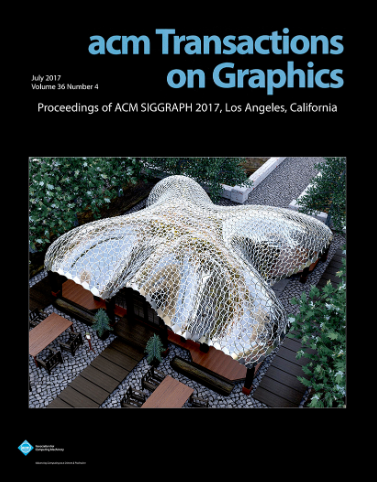Alignment conditions for NURBS-based design of mixed tension-compression grid shells
IF 7.8
1区 计算机科学
Q1 COMPUTER SCIENCE, SOFTWARE ENGINEERING
引用次数: 0
Abstract
In architecture, shapes of surfaces that can withstand gravity with no bending action are considered ideal for shell structures. Those shells have special geometries through which they can stream gravitational force toward the ground via stresses strictly tangent to the surface, making them highly efficient. The process of finding these special forms is called form-finding. Recently, [Miki and Mitchell 2022] presented a method to reliably produce mixed tension-compression continuum shells, a type of shells known to be especially difficult to form-find. The key to this method was to use the concept of the Airy stress function to derive a valid bending-free shell shape by iterating on both the shell shape and the Airy stress function; this turns a problem that is over-constrained in general into a problem with many solutions. In [Miki and Mitchell 2022], it was proposed that the method could also be used to design grid shells by tracing curves on a continuum shell such that the resulting grid has bars that are both bending-free and form flat panels, a property useful for construction of real grid shells made of glass and steel. However, this special type of grid is not guaranteed to exist in general on a mixed-tension compression shell, even when the shell is in bending-free equilibrium [Miki and Mitchell 2023]. Additional conditions must be imposed on the shell shape to guarantee the existence of simultaneously bending-free and conjugate grid directions. The current study resolves the existence issue by adding alignment conditions. We consider several practical curve alignment conditions: alignment with the lines of curvature of the shell, approximate alignment with a bidirectional set of user-prescribed guide curves, and exact alignment with a single direction of user-prescribed guide curves. We report that the variable projection method originally used to solve the form-finding problem in the work of [Miki and Mitchell 2022] can be successfully extended to solve the newly introduced alignment conditions, and conclude with results for several practical design examples. To our knowledge, this is the first method that can take a user-input grid and find a "nearby" grid that is both flat-panelled and in bending-free equilibrium for the general case of mixed tension-compression grid shells.基于 NURBS 的拉压混合网格壳体设计的对齐条件
在建筑学中,能够承受重力而不产生弯曲作用的表面形状被认为是理想的壳体结构。这些壳体具有特殊的几何形状,可以通过与表面严格相切的应力将重力流向地面,从而使其具有很高的效率。寻找这些特殊形式的过程被称为寻形。最近,[Miki 和 Mitchell 2022]提出了一种可靠生成拉伸-压缩混合连续壳的方法,众所周知,这种类型的壳特别难以找形。该方法的关键在于利用 Airy 应力函数的概念,通过对壳形和 Airy 应力函数进行迭代,推导出有效的无弯曲壳形;这就将一般情况下的过度约束问题变成了多解问题。 在[Miki 和 Mitchell 2022]中,有人提出该方法也可用于设计网格壳,方法是在连续壳上描画曲线,这样得到的网格具有既无弯曲又能形成平板的杆件,这种特性对于建造由玻璃和钢材制成的实际网格壳非常有用。然而,这种特殊类型的网格并不能保证在混合拉伸压缩壳上普遍存在,即使壳体处于无弯曲平衡状态[Miki 和 Mitchell 2023]。必须对壳的形状施加附加条件,才能保证同时存在无弯曲和共轭网格方向。目前的研究通过添加对齐条件来解决存在性问题。 我们考虑了几种实用的曲线对齐条件:与外壳曲率线对齐、与用户指定的双向引导曲线近似对齐,以及与用户指定的单向引导曲线精确对齐。我们报告说,在[Miki 和 Mitchell 2022]的研究中,最初用于解决找形问题的变量投影法可以成功地扩展到解决新引入的对齐条件,并以几个实际设计实例的结果作为结论。据我们所知,这是第一种能根据用户输入的网格找到 "附近的 "网格的方法,这种网格既是平面网格,又处于无弯曲平衡状态,适用于拉伸-压缩混合网格壳体的一般情况。
本文章由计算机程序翻译,如有差异,请以英文原文为准。
求助全文
约1分钟内获得全文
求助全文
来源期刊

ACM Transactions on Graphics
工程技术-计算机:软件工程
CiteScore
14.30
自引率
25.80%
发文量
193
审稿时长
12 months
期刊介绍:
ACM Transactions on Graphics (TOG) is a peer-reviewed scientific journal that aims to disseminate the latest findings of note in the field of computer graphics. It has been published since 1982 by the Association for Computing Machinery. Starting in 2003, all papers accepted for presentation at the annual SIGGRAPH conference are printed in a special summer issue of the journal.
 求助内容:
求助内容: 应助结果提醒方式:
应助结果提醒方式:


